For almost a year, Yandex has been presenting
Alice’s cash
prize for the most popular and interesting skills for her voice assistant. Anna Savinkova, not being a programmer, game developer, or ux designer, developed the Citadel voice quest in two parts, each of which managed to win an Award in the Games and Entertainment category.
Under the cut is her story about finding a tool for development, the complexity of voice navigation around the game, designing a “backpack with artifacts” using JavaScript, setting up health points with bites of wolves and healing bastard fat, experimenting with the audience and promoting a voice game on social networks. Suddenly this experience will help you win.
Well, a picture on the topic "How to develop a prize skill with your own hands", and at the same time - an original illustration for the "Citadel".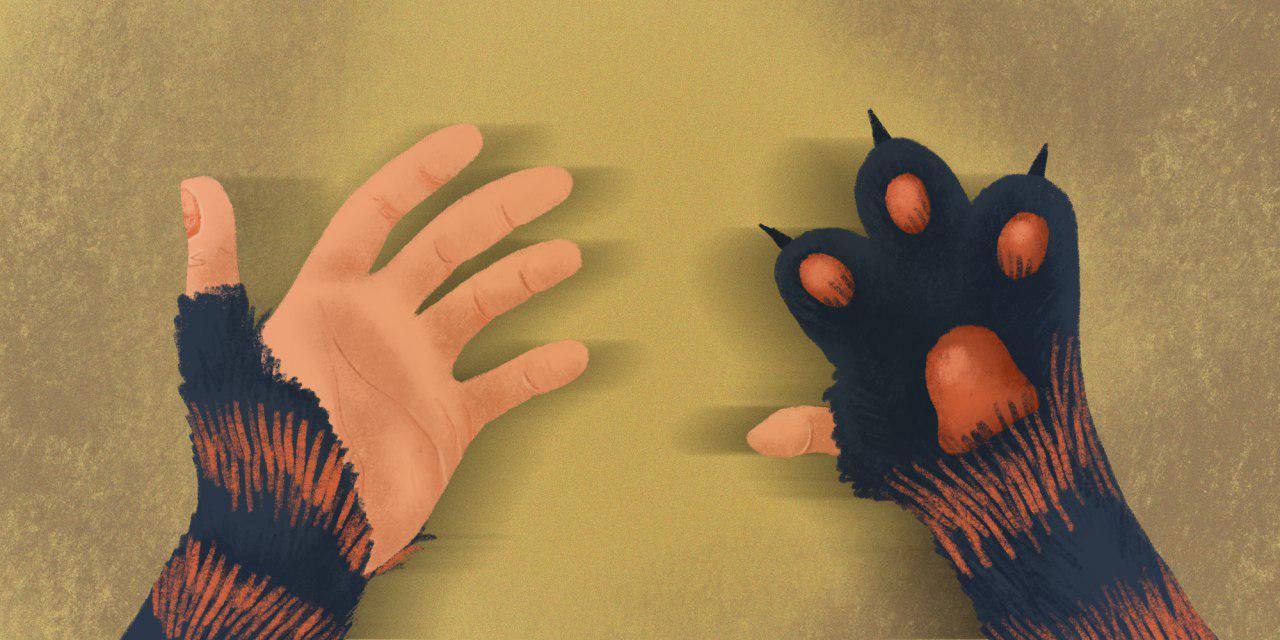
I really am not a programmer, although I have some experience in the form of independent development and layout of sites. Passion for conversational bots began last year, when Yandex had just opened a beta version of Dialogs. Then I wanted to give a present to my colleague's birthday: a quest with the help of Alice looking for a gift at the office. From this first quest-skill, the topic of voice bots became interesting to me.
Skill idea and tool selection
The idea of the
"Citadel" came by chance after studying the library of Alice's sounds: since there are zombie sounds, it means you have to make a game about zombies! In fact, the entire script was invented to the existing sounds in the Yandex library. And from June, by the way, it became possible to add your own audio files (each record should be no longer than two minutes, but in total you can upload up to 1 GB of records).
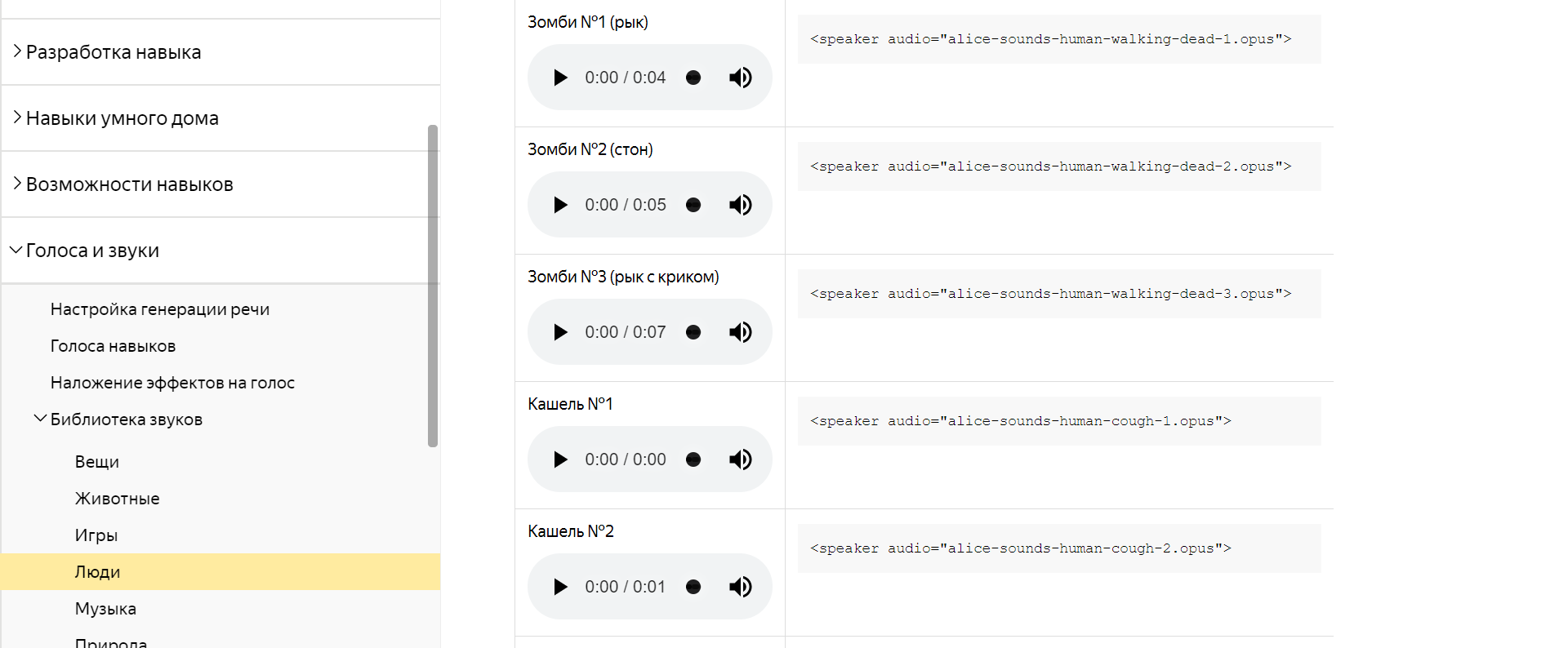
I had a practice of deploying skills on my own in Python, but it became too lazy to pay for hosting ̶̶ ̶̶̶̶̶̶̶̶ ̶̶̶̶̶̶̶̶̶̶̶̶ ̶̶̶̶̶̶̶̶̶̶̶̶ ̶̶̶̶̶̶̶̶̶̶̶̶, so I had to switch alternately from the Alfabot service to Verter and vice versa, until somewhere I saw an article about the
Aimylogic constructor from Just. For the sake of fun, I made a couple of skills with http requests, played around with variables, and I really liked this functionality. I really fell in love with the Aimylogic interface, probably because of the arrows. I love mind maps, and the fact that this is exactly what the script looks like in Aimylogic has become a decisive factor in choosing a service.
The game scenario pounced in a regular dock:
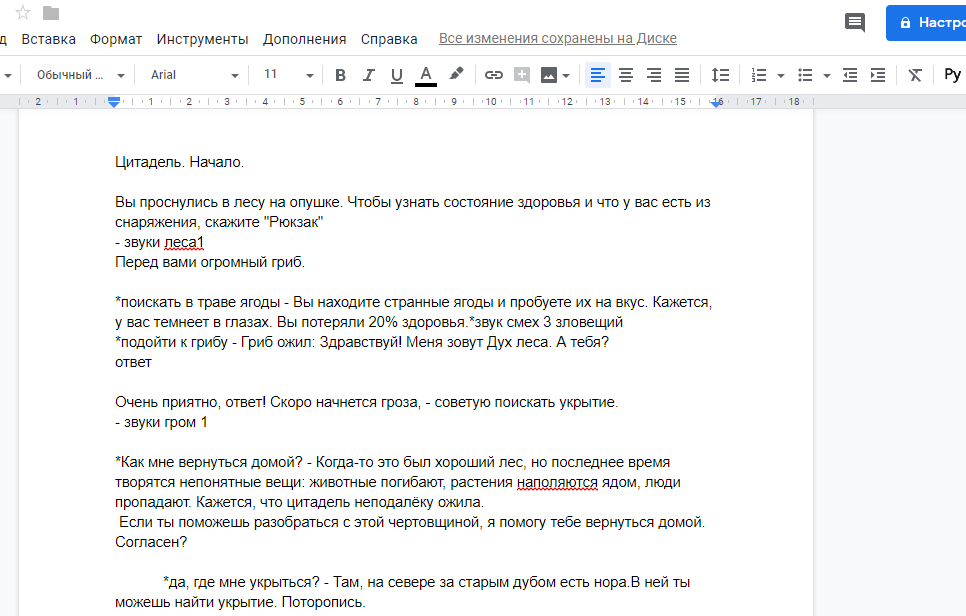
Briefly about the plot, the player in the "Citadel" needs to collect items for survival and use them in fights with enemies. To find out your health level and check what a player has outfit, you just need to tell Alice the code word “Backpack” - it contains the found artifacts.
A feature with a backpack was born immediately, because the "artifacts" and the level of HP for gamers are our everything. The texts in the end, alas, had to be slightly reduced due to the restrictions on the number of characters: first, due to Alice's limit of 256 characters, then due to the impossibility of a quick webhook response combined with an image and phonetic markup. But later this issue was resolved.
Another idea that I rejected is a “by ear” navigation system around the world. This is a matter of convenience of the voice interface. For some reason, I didn’t want to torment the user and make me remember by ear: before that, he went north or west. Therefore, easily remembered locations were invented with a hollow, a warehouse, a barn, a forge, etc.
How the Citadel Works
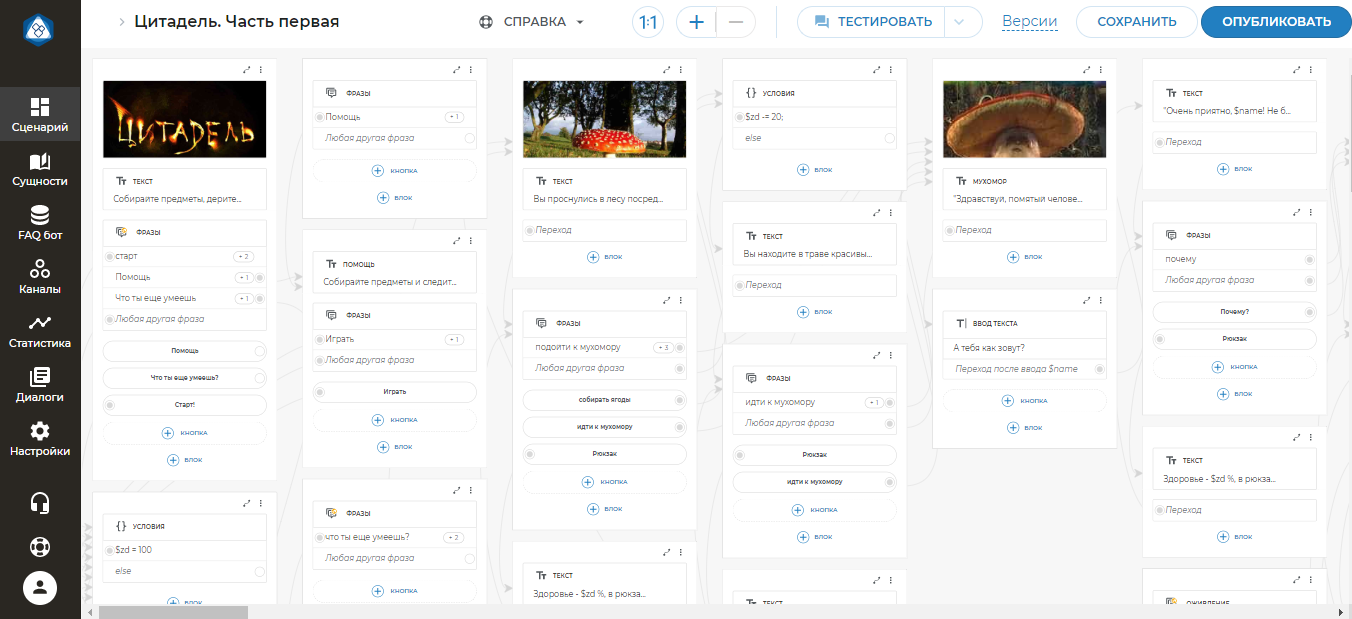
The first screen is the start of the game and the greeting of the player. The game specifically begins with the rhetorical question of whether the user is ready to start the quest, so that before the start of the main scenario, enter the two variables $ loot and $ zd that are needed in the game, which store the values of health indicators and artifacts in the backpack.
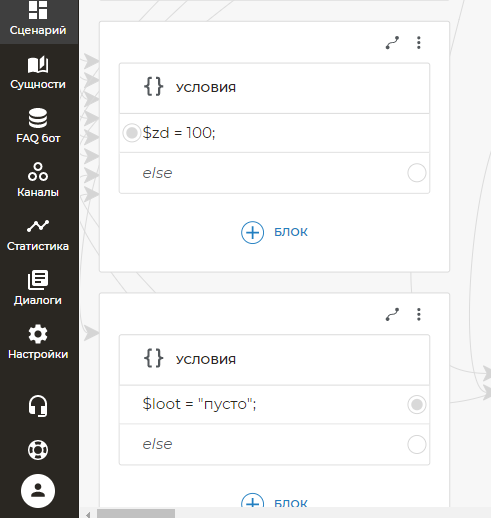
Accordingly, as soon as a player eats poisoned berries, by a simple arithmetic action of subtraction, we reduce his health indicator. Initially, the balance assumed that the berries would take up 50% of their health, and in combination with the bites of the wolves a gameover would occur, but subsequently it was necessary to abandon it. Why - more on that later.
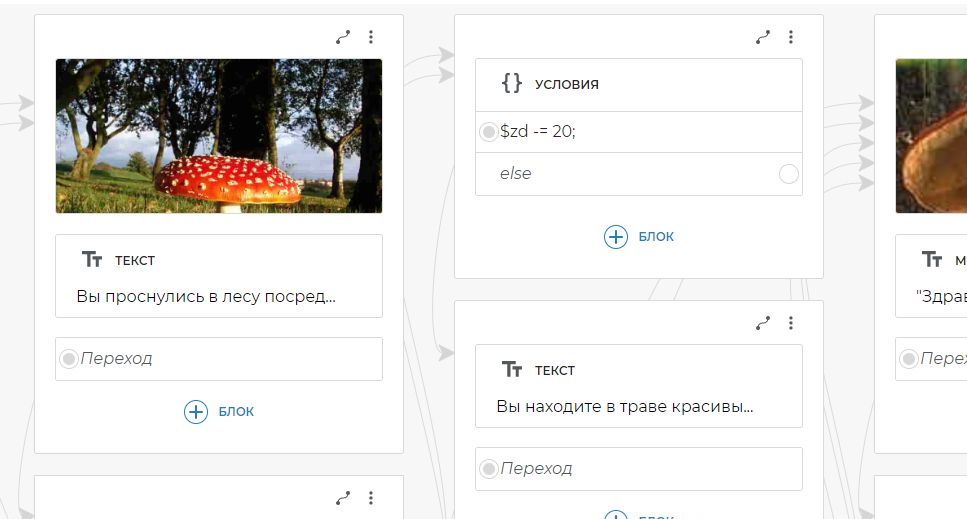
How is the backpack
As mentioned above, the level of health and artifacts are variables that exist separately from the blocks, which you can enter in Aimylogic yourself (which, by the way, I did not see in other services, although it is possible that someone else has this functionality).
Now the backpack consists of three blocks. A block with phrases is specially separated from a block with script text. Initially, the backpack was made up of two blocks, but after testing it became clear that the content that was being repeated anew after “calling” the backpack began to annoy even me, not to mention users.
For this, a block of phrases had to be taken out each time so that the content would not be repeated. The buttons are left specially so that the user does not have the feeling that something went wrong when calling the backpack and this is the end of the script. Although a number of slippers from other developers have already flown through the buttons for me - yes, yes, everything is clear, this is the voice interface and the buttons kill the very idea of a voice game.
What does a backpack look like in Aimylogic:
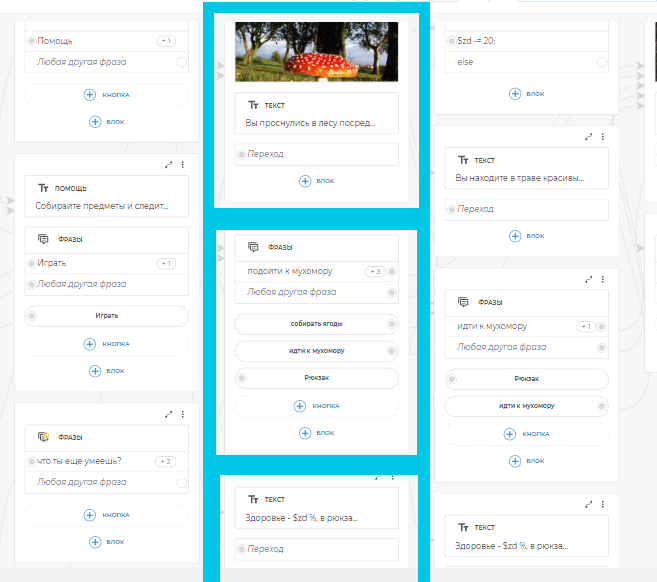
If everything was simple with the numerical values in the health variable, then to accumulate artifacts in the backpack, I had to dig into the JavaScript tutorial and discover the operation of adding string values.
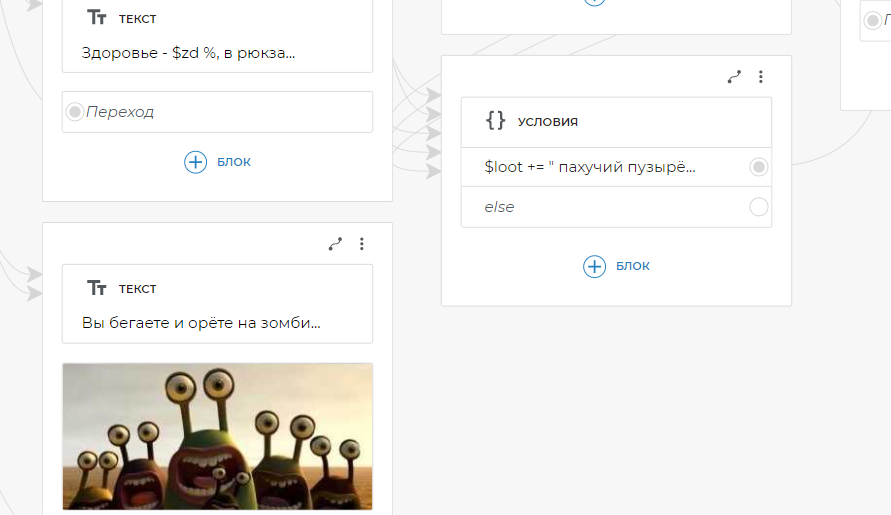
Speech recognition problem
In case of incorrect recognition of the user's response, when none of the possible answers is provided in the game logic, it is better if the error is interpreted in favor of the user, because the show must go on. To do this, the script excluded the possibility of repeating the same content if the answer was not recognized. There is a possibility that the user may be annoyed when the script "loops" in the same place with the wrong answer. But this is specific to the Citadel. On the other hand, if the game is with a high level of difficulty, then probably this can be justified.
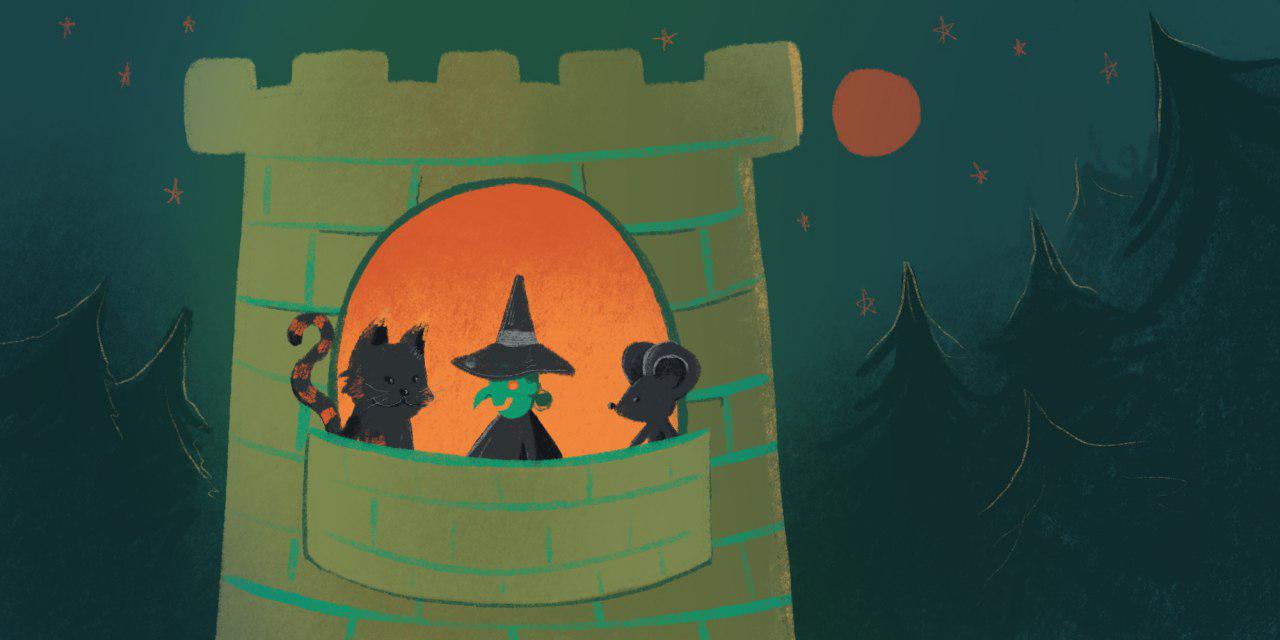 One of the illustrations for the "Citadel"
One of the illustrations for the "Citadel"Locations and Shatoka Fat
So that there was no difference in the sequence of visits to locations with artifacts, a function was used to compare the values of variables, including with the "shatko fat". This is done so that the player had a choice - to go first to the forge or to the warehouse, and at what point should he regain his health. By the way, according to statistics, most players do not immediately eat fat, but leave it for later.
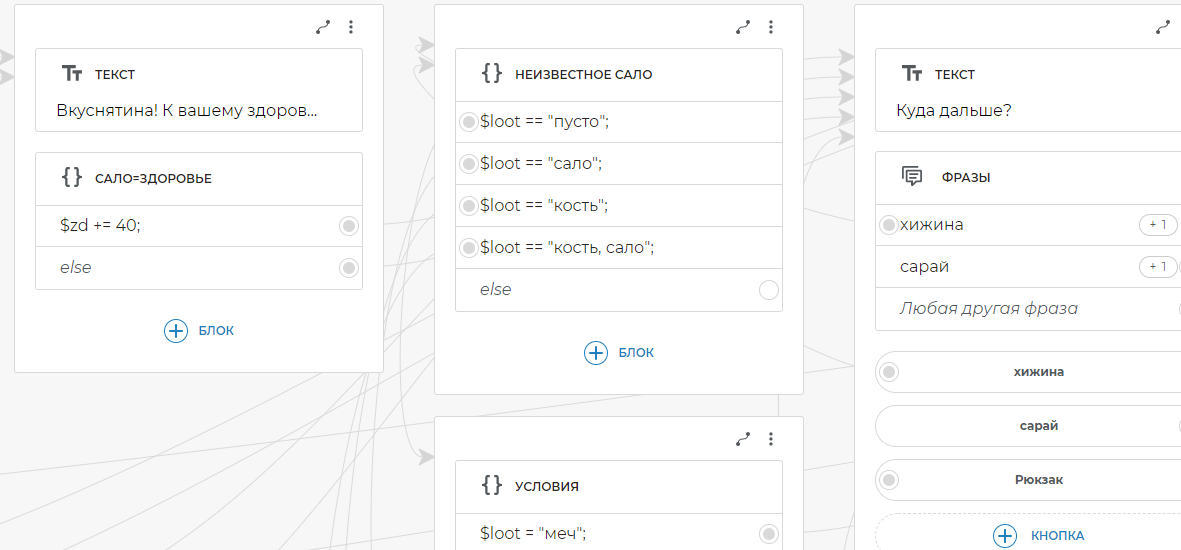
Promotion
To increase the recognition of the game, a VKontakte group was created, a channel in Yandex.Zen, and a small target for Yandex.Browser users in VK was launched.
Yandex ZenAs for Zen, because of the “karma” mechanism, the effectiveness of publications has been evident since the third week, when the post received more coverage. The first publications did not get even 2,000 impressions, but the subsequent ones consistently 10,000+.
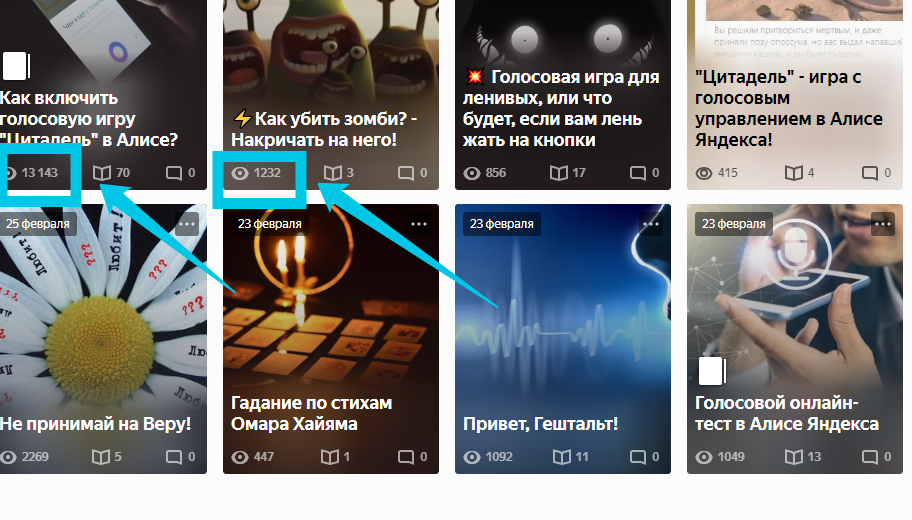 Facebook
FacebookA little later, I still tried to connect Facebook, but
I was strangled by a toad, I had to abandon this idea, since there is no targeting for Yandex.Browser users. And with a budget of 500 rubles, only payment for impressions was available. It makes no sense to invite the user into the game for Alice if he does not have Alice or a browser with Alice. It may be that Alice has some of the users installed, but the conversion from showing the ad to passing the game will be scanty. Waste of money.
In contact withVkontakte ads targeted to users under 18 showed the best conversion. The average cost to go to the skill page is 2-3 rubles, if you're interested (diplinks of direct entry into the skill at that time had not yet appeared). And the best-made self-made video service VKontakte advertising account. For the entire time of promotion, about 1,500 rubles were spent on various formats of creatives. Below is an example of a part of the ads:
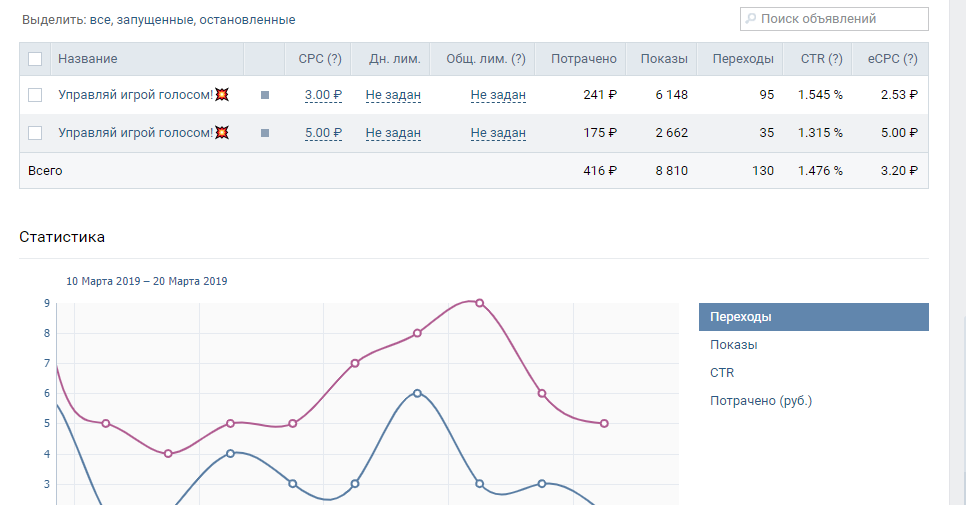
But it was then that the first positive reviews and criticism rained down, which made it possible to make significant changes to the balance of the game and the script.
Reviews VKontakteFor comparison: on the skill page in the Dialog platform, the Citadel has only 5 reviews, and dozens of reviews were sent to the VKontakte group and to the PM, which came as a complete surprise. Some of them had very specific complaints: in terms of picture quality, script, level of difficulty, etc. It is logical that the children will communicate on the site that is interesting to them.
Although I received a lot of messages from just bored children, and a lot of spam. But after the first positive feedback from the children, their eyes were really in a wet place, because I did not think that they would react so positively to the game and would write thanks. This is incredibly touching.
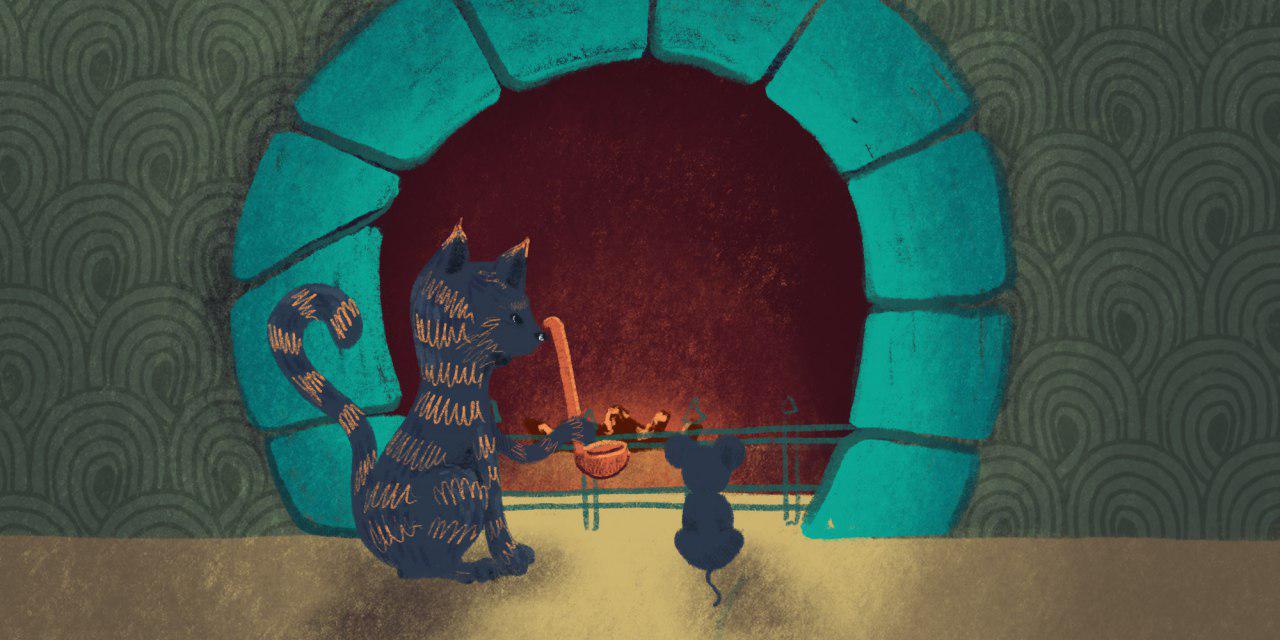
Alteration
Two weeks later, it became clear that most of the children did not reach the end of the game and did not return after the second or third “death”. I had to reduce the number of possible "deaths" and give the opportunity to significantly improve the character's health with "shatoo fat." Even with the perfect passage of the game with a significant imbalance of 140% health, although in a good way you need to correct it to 100%.
But the children were happy - which was required! After that, the number of returns to the game increased, and those who went through in every way began to look for “Easter eggs” and all kinds of options. From several reviews it gradually became clear that not everyone knows how to run skills in Alice, install the application, and for this a separate FAQ was made in the group.
The target audience
The main target audience is children from 10 to 17 years old. As well as adults - lovers of text quests and role-playing games on mobile platforms. Below are statistics on the separation of users by gender and age, who reacted positively to the call to try the game:
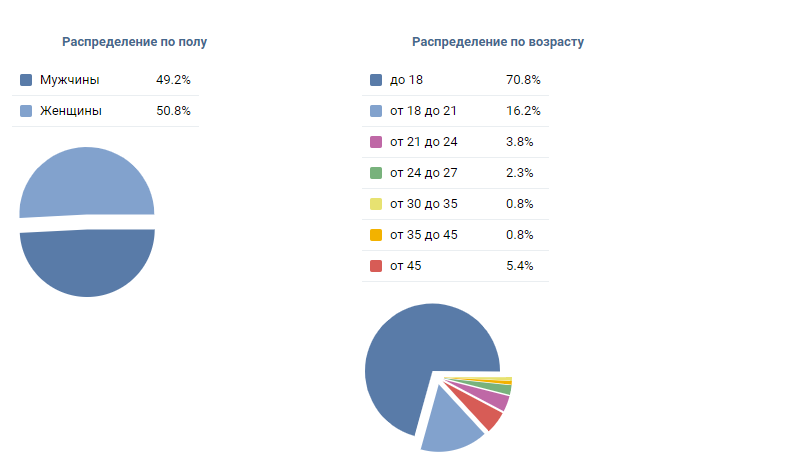 Target audience and statistics issues
Target audience and statistics issuesWhen targeting separately to an adult audience, I got the impression that due to the lack of a limit on the number of impressions per user and the annoying advertising of VKontakte when choosing a payment for a conversion, a flurry of “stakes” in skill ratings started. That is, it was clear that on the day of testing an audience aged 30+, several people did not enter the game at once, but a few were put in. Probably for annoying ads. Perhaps this is the wrong conclusion, but I did not want to test an adult audience for a longer period.
But this conjecture is confirmed by statistics targeting the same ad, the same audience with a difference only in age:
30+ audience target metrics. 927 hidden out of 1,554 views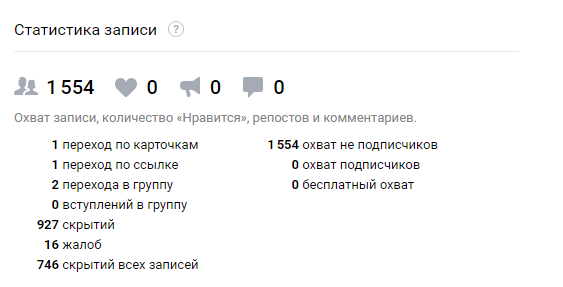 Target audience targets under 21. 262 hidden from 19,000 (!) Views
Target audience targets under 21. 262 hidden from 19,000 (!) Views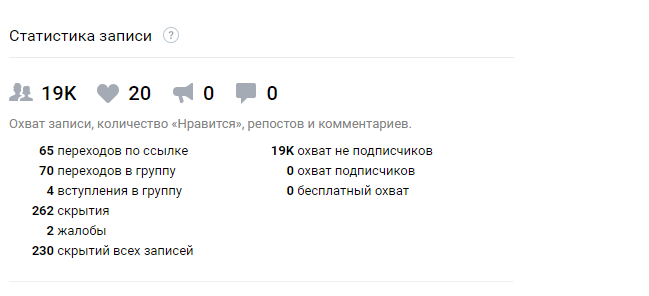
It would be nice to have advanced statistics in Aimylogic in the format of web analytics using the example of Google Analytics, when you can see not only statistics of traffic, sources of call, but specific statistical sections: from which specific block does the percentage of users leave, or hitch, or data on the percentage of users' choices in one direction or another of the dialogue, when the dialogue is “reset” to the beginning and many, many other usefulness that business chats will definitely need.
Traffic from Alice's Catalog
Since Yandex has allocated quests and quizzes in a separate subcategory on the main page in the catalog, I also wanted to get into the quest category. And not in vain - traffic has grown significantly after getting into the right category. Although the biggest traffic boom was from the “New Products” section: more than 1000 users per day. How to get into the "New" - is still a mystery. The "Citadel" was there after a long time, and this is far from 2-3 days (the second part of the game hit the "News" already faster, about a week later).
Twice into the same water: Alice’s second Prize for the second part of the Citadel
Inspired by the debut, I immediately planned to do the
second part of the “Citadel” together with simply amazing illustrator-artists from Miroedova School (all the illustrations for the game in this post are their talented hands), who volunteered to help with complex illustrations for the script with bare enthusiasm.

Work on the second part, taking into account the creation of copyright illustrations, selection and mixing of sounds, took a total of about three months. Perhaps the process was several times more laborious than during the work on the first part. In the voice acting of the characters of the second part of the Citadel, the Yandex SpeechKit test bench was used - not a single living actor was involved. Both parts are interconnected by the plot: at the end of the second part you find yourself in the meadow you already know from the first. In a way, this is Groundhog Day.
There are no plans for the third part yet, but both parts of the Citadel will definitely be finalized and will receive a new life in other assistants. So, for example, it is planned to localize the first part for English-speaking users of Google Assistant.
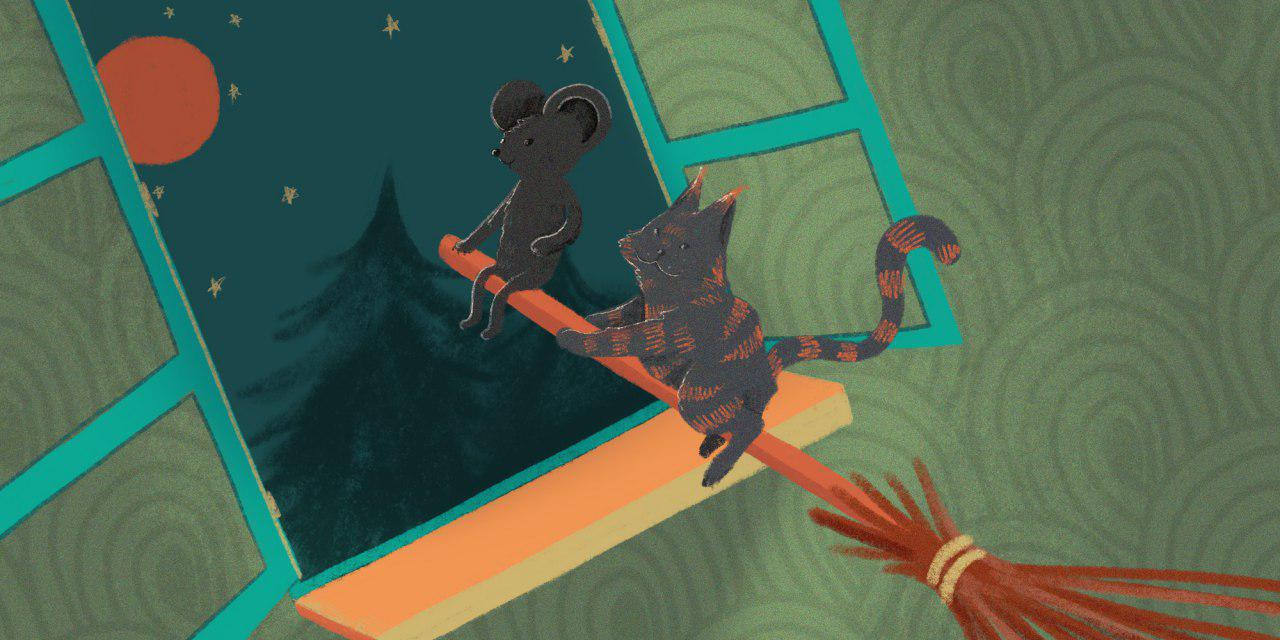
What's next
I also have a small but promising business project in development with partners from Chelyabinsk, from which I would like to make a ready-for-sale solution based on the Aimylogic service. In short, it will be related to the alcohol theme and tailored to a specific audience of lovers of bars and pubs.
Now we will measure marketing business indicators using the example of this specific small business entity: such as LTV, CRR, and ATV before introducing the use of the voice bot, and then measure them over the same period of time after, and compare. The result is unpredictable, but expected. There are either no or very few cases of using voice assistants, so it will be useful for the entire community of voice interfaces. Time will tell.
I also have ideas for gaming educational skills and a premonition that this should be done not as an indie, but as part of team projects, since the volume of labor along with ideas is increasing. But there is an understanding of how to build processes for several participants at the same time.